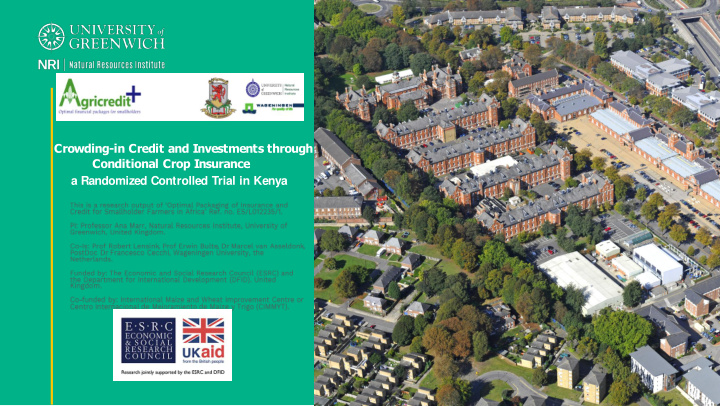



Crowding-in Credit and Investments through Conditional Crop Insurance a Randomized Controlled Trial in Kenya
• • • • • (Karlan et al. 2015) • ↓ (Emerick et al. 2016) • (Dercon et al. 2011, Dercon et al. 2014)
We offer a FREE hybrid crop insurance CONDITIONAL on uptake of certified (e.g. drought-tolerant) seeds: more seeds = more insurance Hope to break the vicious cycle of under-insurance, under-purchase of quality seeds, under-investment in agricultural inputs, low yield
Does the offer of a free conditional crop insurance... • Increase the uptake of conditional inputs (certified seeds)? • Crowd-in credit demand and investments in non-conditional inputs? • Increase production at extensive (land) and intensive (yield) margins? • Increase the willingness-to-pay (WTP) for future insurance?
Y i = β 0 + ITT i β 1 + X i β 2 + UAI i β 3 + ε ig • 803 (attrition=23) smallholders in Meru County, Y i = Outcome 40 farmer groups ITT i = Intention to treat • Individual level randomization: 40% to treatment X i = age, age squared, male respondent dummy, years of education, household size, catholic dummy, asset index, • Free insurance proportional to amount of certified livestock TLU, share invested in risk preferences game, seeds purchased total land, number of fields having access to, bank account dummy, value of total bank savings, and a dummy for if the • Four crops: maize, sorghum, soya and sunflower farmer group was supplied by only one input supplier UAI i = Unit Area of Insurance spatial dummy • Insurance is hybrid: partially indemnity based dummies partially index based Standard errors clustered at the farmer group level (40)
• Smallholders respond by increasing farming efforts both at the extensive margin and intensive margin • They are more likely to adopt certified seeds, but also invest more overall in unconditional inputs • They are more likely to try to obtain formal credit, and borrow more • No clear evidence that farmers increase or decrease their productivity or income as a consequence of these increased investments • Farmers respond to treatment by increasing their own willingness to pay for insurance in the future
• Insurance reveals its potential to be used as a policy instrument to increase the adoption of desirable farming practices • Insurance crowds-in borrowing and investments in other farm inputs more than proportionally: it maybe more effective to offer insurance than give inputs directly • Insurance WTP increases after adoption: temporarily offering discounted insurance may well be a sustainable policy tool to enhance future unsubsidized uptake and impact
Recommend
More recommend